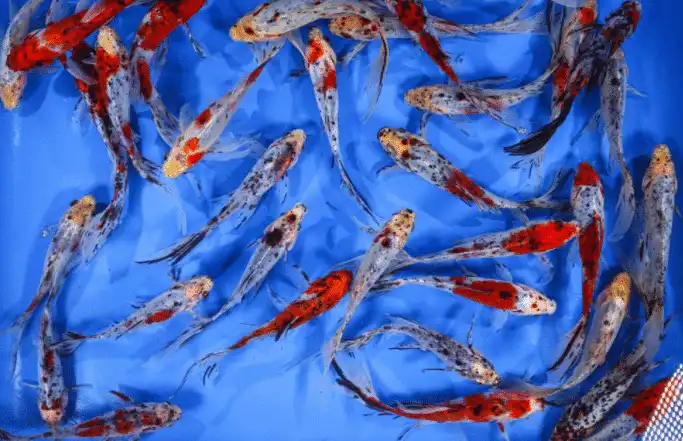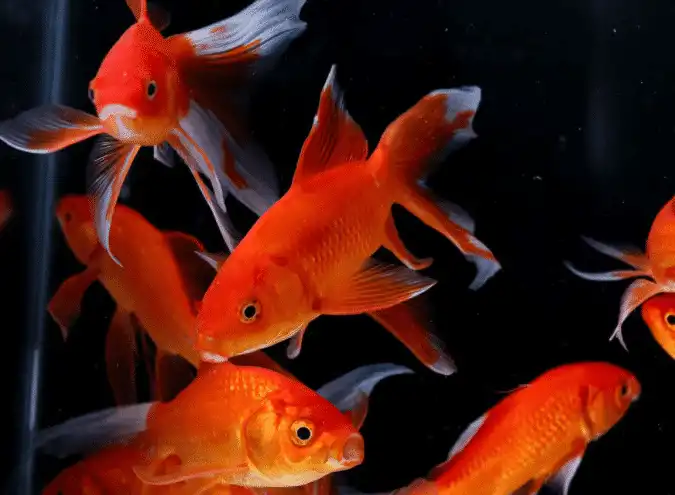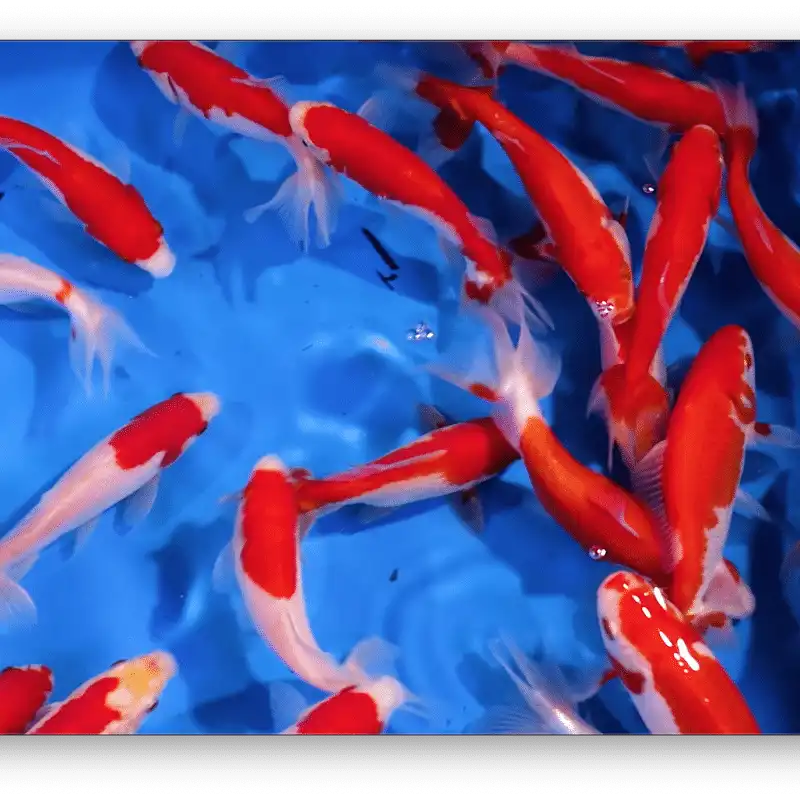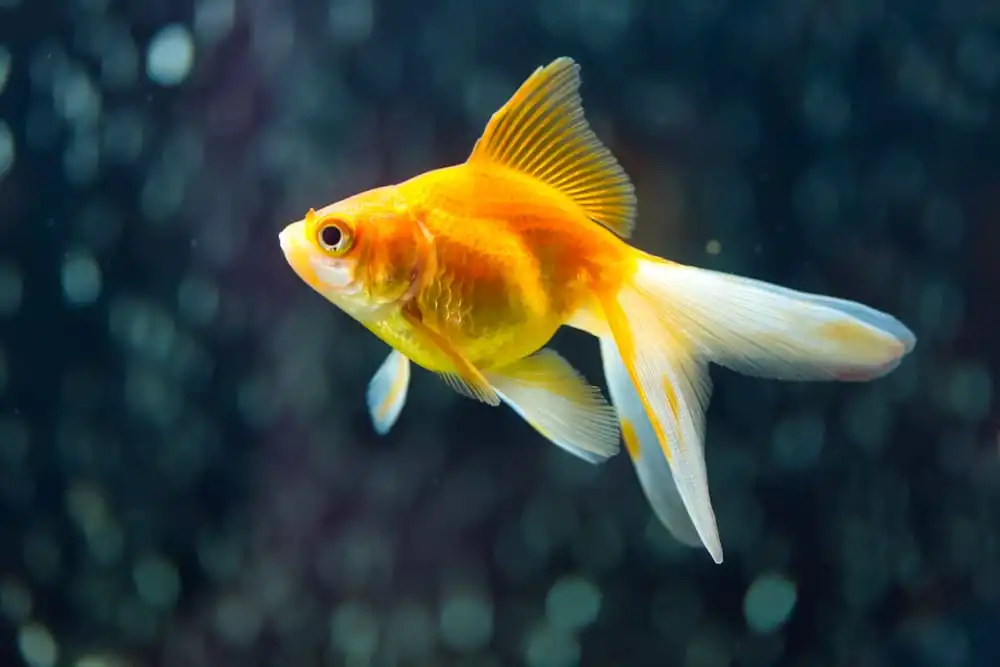Thank you for visiting! By the way… any links on this page that lead to products on Amazon and other stores/partners are affiliate links Aquarium Store Depot earns a commission if you make a purchase.
Goldfish are probably the world’s most popular freshwater aquarium fish, and with over 200 recognized types of goldfish, there’s a breed for everyone!
Read along as we introduce 35 awesome goldfish breeds that you can keep in your aquarium!
Key Takeaways
- Goldfish have a rich history, and they come in a wide range of shapes, sizes, and colors
- Slim-bodied goldfish are cheaper, hardier, and easier to care for than fancy goldfish
- Fancy goldfish require more care than slim-bodied breeds
- Some goldfish breeds can grow to over 12 inches, so they need plenty of space and high-quality filtration to stay healthy
Species Background
The goldfish (Carassius auratus) is a freshwater fish from China that is kept in aquariums and ponds all over the globe. These fish prefer cool, slow-flowing, or still water in nature, and the largest individuals can grow to over 16 inches long and weigh over 5 pounds if they have enough space.
Aquarists have long prized the goldfish for its grace and beauty, and they first started breeding these fish over a thousand years ago! Today they are as popular as ever, and selective breeding has created an awesome variety of different breeds.
Slim-bodied Vs Fancy Types – What’s The Difference?
The two major goldfish breed categories are slim-bodied and fancy breeds – read on to learn more about these goldfish types.
Slim-bodied Varieties
Slim-bodied goldfish like common, feeder, and comet goldfish have been bred into many colors, although their streamlined, torpedo-shape is just as nature intended. These are the most common and most affordable breeds of goldfish and the type most people are familiar with.
Slim-bodied goldfish are hardy and very easy to care for without any advanced care requirements. That means they make excellent beginner fish, as long as you can provide the following basic requirements:
- Enough space
- High-quality goldfish food
- Regular maintenance to ensure good water quality
- Adequate filtration
- Cool water temperatures
Let’s take a look at some of the pros and cons of the slim-bodied breeds
Pros:
- Slim-bodied goldfish come in a range of beautiful colors and fin types
- Slim-bodied goldfish are very affordable. You can usually find feeder goldfish for less than a dollar each!
- These fish are super easy to find at just about any pet store
- Common goldfish are very hardy, which makes them great for an outdoor pond
Cons:
- Slim-bodied goldfish get surprisingly large and their active swimming habits make them unsuitable for small aquariums
- Goldfish are natural omnivores, and these faster swimming varieties can catch and eat small tank mates
Fancy breeds
Fancy goldfish are the product of centuries of careful selective breeding, and the results are adorable! These fish may have strange, bulging bubble eyes, humped backs without dorsal fins, or even bulbous growths on their foreheads and gill covers.
However, such extreme variation has come at a cost, and these eye-catching features make them much more sensitive, which means they require more specialized care. They are more expensive too, so these goldfish breeds are better suited to more experienced fish keepers.
Let’s take a look at a few more pros and cons of keeping fancy goldfish.
Pros:
- Fancy goldfish have been bred into some truly adorable shapes, and their clumsy movements make them very entertaining
- Fancy goldfish can be fascinating to breed for more advanced hobbyists
- Fancy goldfish are relatively small goldfish breeds, although most types can reach 6 to 8 inches
Cons:
- Fancy goldfish can be pretty expensive, particularly when you start looking at rare varieties
- Sensitive breeds like bubble eyes and celestial goldfish have fluid- filled sacs under their eyes that are easily damaged
35 Types Of Goldfish
Now that you know a little more about the differences between fancy and slim-bodied goldfish breeds, let’s go ahead and meet 35 of the world’s most popular goldfish breeds! We have a YouTube video just for you from our channel. Our blog post goes into more detail so follow along with both!
1. Shubunkin
Editors' Choice
Coloration, patterns, and it's Koi-like features make this goldfish one of the most popular for ponds
- Goldfish Type: Slim-bodied
- Adult Size: 9 – 18 inches
- Color Pattern: Multi-colored blotches and spots (calico)
- Unique Traits: Hardy goldfish with great colors, suitable for ponds
Shubunkin goldfish are popular slim-bodied goldfish with a mottled and multicolored (calico) pattern. Pretty much any calico goldfish with a single tail can be called a shubunkin, so this breed is highly variable in shape. However, there are three common shubunkin variations that you are likely to come across.
London Shubunkin goldfish look like a typical common goldfish with calico patterning, while American shubunkin goldfish have much longer fins like a comet goldfish. The Bristol shubunkin is an interesting variant with larger, rounder tail fins that look somewhat heart-shaped.
2. Feeder
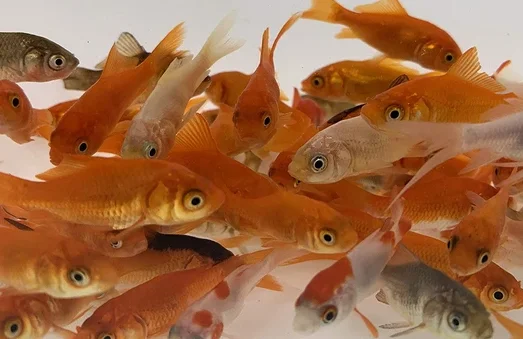
- Goldfish Type: Slim-bodied
- Adult Size: 6 – 12+ inches
- Color Pattern: Various
- Unique Traits: None
The feeder goldfish is not exactly a breed but rather a class of feeder fish sold as a live food source for other fish and pets like turtles. They are usually common or comet goldfish that have poor color or body shape, but that doesn’t mean they can’t make great pets.
Feeder goldfish are very cheap and they can have great colors and fins too. The problem is that some breeders don’t take great care of these fish, so they might be in poor condition when you pick them up.
3. Comet
Best Value
The Comet is a fast, hardy, and well adapted goldfish for aquariums and outdoors ponds
- Goldfish Type: Slim-bodied
- Adult Size: 12 inches
- Color Pattern: Solid color
- Unique Traits: Long, single fins and deeply forked tail
The comet goldfish is a very popular American breed with long, flowing fins. These hardy beginner-friendly goldfish are very affordable and come in a range of colors, including red, orange, yellow, white, and red and white. They are an active breed, suitable for larger tanks and ponds.
4. Sarasa Comet
Best Value
The Sarasa is a great Koi lookalike goldfish variety that offers a variety of colors
- Goldfish Type: Slim-bodied
- Adult Size: up to 14 inches
- Color Pattern: Red & white
- Unique Traits: Long, single fins, deeply forked tail, and white and red coloration
The Sarasa comet goldfish is a popular color variant of the well-known comet goldfish. These eye-catching fish are mostly white, with red markings on their body, and some individuals also have red on their fins.
Like the regular comet, Sarasa comets do great in outdoor ponds, and they really stand out with those bright contrasting colors!
5. Wakin
With their elongated bodies and unique fins, Wakins are a flash of color and character to your pond
- Goldfish Type: Slim-bodied
- Adult Size: 10 to 18 inches
- Color Pattern: Various solid colors and calico
- Unique Traits: Double-tail
Wakin goldfish are a popular Japanese breed, identified by their double tail. They were developed from the common goldfish and look very similar apart from their extra tail fin.
Wakin goldfish are a great alternative for fishkeepers who want the interesting features of a fancy breed, but the active and hardy nature of a slim-bodied goldfish.
6. Fantail
Use Coupon Code: ASDEPOT
You can purchase what you see is what you get (WYSIWYG) Fantail Goldfish from NextDayKoi. They are one of the best fancy goldfish for aquariums and specialized ponds
- Goldfish Type: Fancy
- Adult Size: usually 6 – 8 inches
- Color Pattern: Various
- Unique Traits: Egg-shaped body, Double tail and anal fins, high dorsal fin
Fantail goldfish are popular for their heavy, egg-shaped body and wonderful fins. They have amazing flowing tail fins and anal fins and are available in a bunch of beautiful colors.
Fantail goldfish are true fancy goldfish, although they are relatively hardy and affordable compared with rarer fancy breeds.
7. Jikin
- Goldfish Type: Slim-bodied
- Adult Size: 8 – 10 inches
- Color Pattern: Usually red & white/ orange & white
- Unique Traits: X-shaped double tail
The Jikin goldfish (video source) or peacock-tail goldfish is a rare Japanese goldfish breed with a unique double tail that spreads outward.
They are an expensive breed, similar to the Wakin apart from their unusual tail which looks like the letter X when viewed from behind.
8. Watonai
- Goldfish Type: Slim-bodied
- Adult Size: 10 – 12 inches
- Color Pattern: Various
- Unique Traits: Long double tail fins
The Watonai goldfish (video source) is a double-tail and double anal fin breed with long tail fins, kind of like a double-tailed comet goldfish, or a long-tailed wakin.
Watonai goldfish were first bred in Japan in the early 1900s, making them a relatively new breed. These beautiful fish are rare but fairly hardy and easy to care for.
9. Ranchu
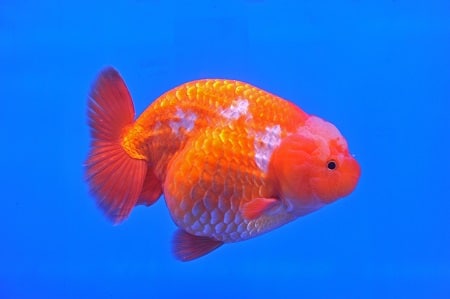
- Goldfish Type: Fancy
- Adult Size: 6 – 8 inches
- Color Pattern: Various
- Unique Traits: ‘Hooded’ head, steeply curved lower back and no dorsal fin
The Ranchu goldfish is one of the most unusual and adorable goldfish breeds in the world. They are a Chinese fancy goldfish breed with a deep, egg-shaped body and bubble-like growths on their head known as a wen or hood. These fish also lack a dorsal fin and have a single tail fin.
Ranchu breeds vary somewhat depending on their country of origin. Some breeds are still bred to look their best from above, while others are judged from the side.
The Ranchu is a relatively delicate and sensitive breed, ideal for more experienced goldfish keepers. They are pretty slow-moving, clumsy fish that will do best with other fancy goldfish types for tankmates.
10. Thai Ranchu
- Goldfish Type: Fancy
- Adult Size: 6 – 8 inches
- Color Pattern: Various
- Unique Traits: Large Wen, V-shaped tail, and high curved back
Thai ranchu goldfish (video source) are a local variant of the ranchu that are bred in Thailand, Southeast Asia. These unique fancy goldfish have a unique body shape and a very large wen (hood).
This breed has a high curved back with the highest point closer to the tail, and like other ranchus, they have no dorsal fin. This breed is best viewed from the side, unlike Japanese ranchu which are assessed from above.
11. Butterfly Tail
- Goldfish Type: Fancy
- Adult Size: 5 – 8 inches
- Color Pattern: Various
- Unique Traits: Butterfly-shaped double tail and telescope eyes
The butterfly tail goldfish (video source) is a beautiful fancy goldfish breed with a unique double tail. When viewed from above, their tail spreads out to look just like the wings of a butterfly!
This is a deep-bodied breed that comes in a variety of color patterns, including calico. They also have a high dorsal fin and telescope eyes, which makes them a really interesting breed to observe from above or the side.
12. Lionchu
- Goldfish Type: Fancy
- Adult Size: 5 – 8 inches
- Color Pattern: Various
- Unique Traits: Ball-shaped body with a well-developed hood and no dorsal fin
The Lionchu goldfish (video source) was recently developed in Thailand, and it is a cross between the Lionhead goldfish and the Ranchu goldfish. These two fancy breeds are already pretty similar, but the Lionchu has inherited the curved lower back of the Ranchu and the prominent hood of the lionhead.
Lionchus come in a range of colors, including single, bi-colored, and calico patterns. They are fairly sensitive fish, ideal for more experienced fancy goldfish keepers.
13. Ryukin
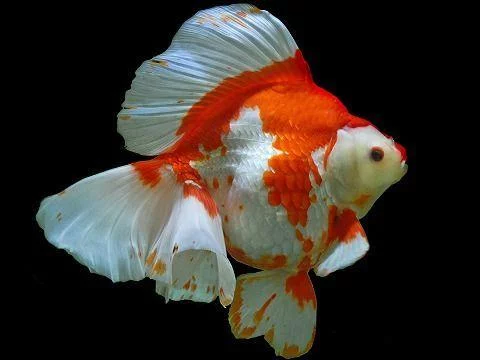
- Goldfish Type: Fancy
- Adult Size: 5 – 8 inches
- Color Pattern: Various
- Unique Traits: Very long triple or quadruple tail
The Ryukin goldfish is a fancy breed with a very wide body and a distinctive humped back. These fish have a high dorsal fin and a very long 3 or 4-lobed tail.
This Chinese breed is relatively hardy and makes a great starter fancy goldfish. They can even be kept in ponds with other goldfish like commons and comets in a well-maintained pond.
12. Telescope Eye
- Goldfish Type: Fancy
- Adult Size: 4 – 10 inches
- Color Pattern: Various
- Unique Traits: Strange protruding eyes
The telescope eye goldfish is another great Chinese fancy goldfish breed that is also known as the dragon eye goldfish. These fish come in many color patterns, including interesting varieties like calico, panda, and redcap.
Telescope goldfish are named for their remarkable protruding eyes but they have other fancy breed features similar to the fantail goldfish. Their care is pretty straightforward, although you should keep sharp objects out of their tank to protect their sensitive eyes.
13. Bubble Eye
- Goldfish Type: Fancy
- Adult Size: 3 – 5 inches
- Color Pattern: Various
- Unique Traits: Huge bubble eyes
The bubble eye goldfish is one of the strangest fancy goldfish varieties and looks very different from its wild slim-bodied ancestors!
These small goldfish have been bred to have huge fluid-filled sacks below their eyes, which leaves them pretty clumsy and vulnerable to boisterous and aggressive fish.
They are a good choice for seasoned goldfish keepers, but also for less experienced aquarists that are willing to put in the planning and effort to create the ideal goldfish tank.
14. Froghead
- Goldfish Type: Fancy
- Adult Size: 4 – 6 inches
- Color Pattern: Various
- Unique Traits: Small bubble eyes
The froghead or toadhead goldfish is a great breed for goldfish enthusiasts that are interested in the history of the hobby.
In fact, the froghead is believed to be the ancestor of the modern bubble eye and celestial goldfish. They appear similar to these breeds, although they have smaller sacs beneath their eyes.
15. Pearlscale
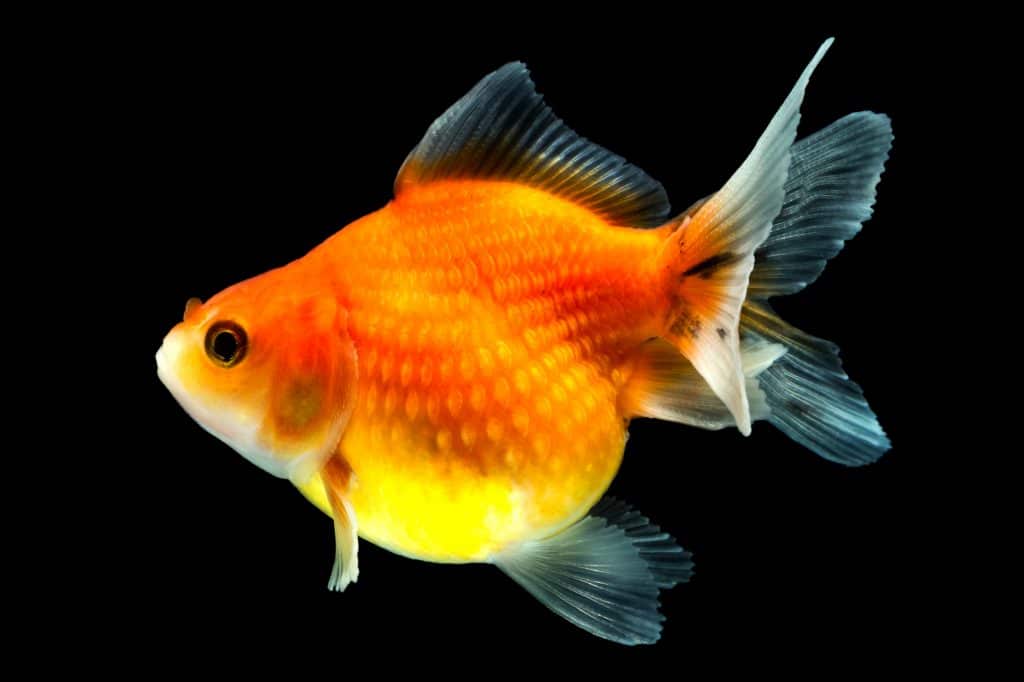
- Goldfish Type: Fancy
- Adult Size: Up to 8 inches
- Color Pattern: Various
- Unique Traits: Golfball-shaped body, with prominent domed scales
The pearlscale goldfish is a large fancy goldfish breed with a ball-shaped body. These fish are named for their domed scales which are widely separated, creating a golfball-like texture. Other features include a double tail and single or double growths on the head.
The pearlscale is one of the more heavily bred fancy goldfish types, so they are not the ideal choice for beginners.
16. Egg Fish
- Goldfish Type: Fancy
- Adult Size: 6 – 8 inches
- Color Pattern: Various
- Unique Traits: Egg-shaped body
The egg-fish goldfish is an ancient Chinese breed that came before many of the popular fancy goldfish varieties we see today. They have a long, egg-shaped body, without a dorsal fin or a wen. These fish are available in many colors and scale types, although they tend to be pretty rare.
17. Oranda
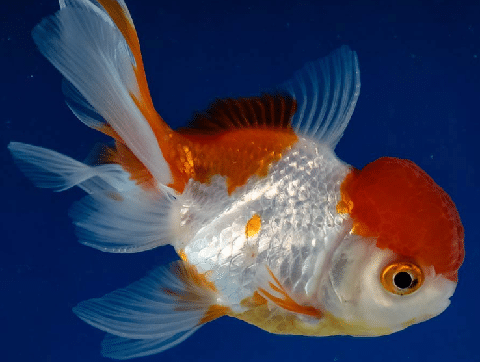
- Goldfish Type: Fancy
- Adult Size: 8 – 12 inches
- Color Pattern: Various
- Unique Traits: Prominent wen/hood
The Oranda goldfish is one of the most popular fancy goldfish breeds, combining large, well-developed fins, a short, rounded body, and a large wen on top of its head which may cover the entire face.
Orandas are similar to the lionhead goldfish but have a dorsal fin and larger fins in general. These fish are available in many colors, and some interesting varieties have a head growth with a different color from the rest of their body and fins.
18. Thai Oranda
- Goldfish Type: Fancy
- Adult Size: 8 – 12 inches
- Color Pattern: Various
- Unique Traits: Highly developed head growth
Thai oranda goldfish (video source) are similar to regular orandas, although have rounder bodies, fuller tails, and well-developed wens that extend onto the gill covers, sometimes covering their eyes.
19. Black Moor
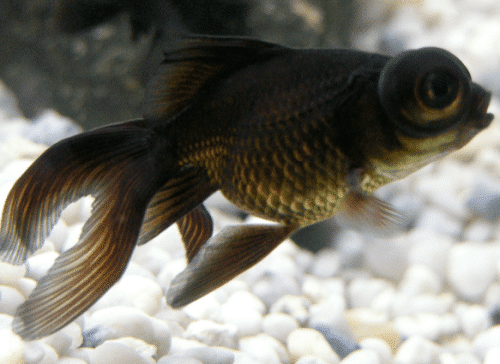
- Goldfish Type: Fancy
- Adult Size: 6 – 8 inches
- Color Pattern: Black
- Unique Traits: Black color and telescope eyes
Black moor goldfish are a very popular breed of all-black goldfish with bulging telescope eyes. This ancient breed was developed in China over 500 years ago where they were originally known as dragon eye goldfish.
Black moors are suitable for beginners, although they are not as hardy as slim-bodied breeds like comets and common goldfish.
20. Red Moor
- Goldfish Type: Fancy
- Adult Size: 6 – 8 inches
- Color Pattern: Red
- Unique Traits: Red color and telescope eyes
The Red Moor goldfish is a variety of telescope goldfish that changes color as it matures. These fish typically start out as Black Moor Goldfish but gradually change into a red color.
21. Veiltail
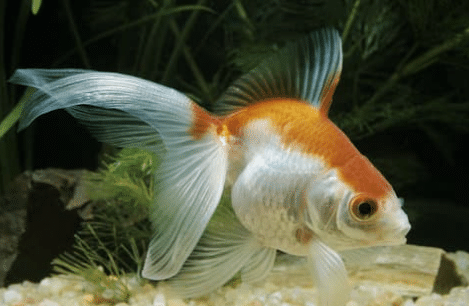
- Goldfish Type: Fancy
- Adult Size: 8 – 12 inches
- Color Pattern: Various
- Unique Traits: Extra-long tail with square edge and sail-like dorsal fin
The veiltail goldfish is an American fancy breed, first bred in Philadelphia in 1890. They are best known for their impressively long double tails and high, sail-like dorsal fin. These fish also have a pointed face and a very deep body shape without a shoulder hump.
They are pretty weak swimmers due to their amazing finnage, so these fish are easily outcompeted by faster tank mates.
22. Celestial Eye
- Goldfish Type: Fancy
- Adult Size: 5 – 6 inches
- Color Pattern: Orange, white, or orange and white
- Unique Traits: Upward-facing eyes and no dorsal fin
The celestial eye goldfish is probably the strangest of all the fancy goldfish types. They are very similar to the bubble eye goldfish but their eyes face directly upwards! Their eyes start out pretty normal but turn upwards after about 6 months.
Celestial eye goldfish are a Chinese or Korean breed that is well over 200 years old. They are fairly easy to care for and they get along great with other goldfish types – just keep sharp objects and decorations out of their tank to prevent eye injuries.
23. Lionhead

- Goldfish Type: Fancy
- Adult Size: Up to 6 inches
- Color Pattern: Various
- Unique Traits: Large head growth, and curved back without dorsal fin
The Lionhead goldfish is an ancient Chinese breed, characterized by an extensive wen (hood) that covers the head, including the gill plates and cheeks. Their wen can take several years to develop fully.
Lionhead goldfish have a gently curved back, without a dorsal fin, and a relatively short tail. They are available in a variety of colors, including bi-colored patterns.
24. Siamese Doll
- Goldfish Type: Fancy
- Adult Size: 6 – 8 inches
- Color Pattern: Pale yellow
- Unique Traits: Red eyes
The Siamese doll goldfish is a pale yellow form of the telescope goldfish with red or orange eyes. They have a deep, rounded body shape and full, well-developed fins including a high dorsal fin. Unfortunately, these eye-catching fish are pretty rare.
25. Sabao
- Goldfish Type: Fancy
- Adult Size: up to 10 inches
- Color Pattern: Red & white
- Unique Traits: Long single tail and deep egg-shaped body
The Sabao, also known as the Tamasaba goldfish (video source), is a rare Japanese fancy goldfish breed with a very long, V-shaped single tail and the deep body of a Ryukin goldfish. They are usually seen in a red and white pattern.
These beautiful fish are pretty large and cold hardy, making them suitable for outdoor ponds.
26. Pompom
- Goldfish Type: Fancy
- Adult Size: 4 – 6 inches
- Color Pattern: Various
- Unique Traits: Ball-shaped nasal growth
Pompom goldfish are an interesting fancy breed with strange ball-like growths on top of their nose. These growths are actually overgrown nasal septa, and their size varies between individuals.
This type of goldfish is available in many colors and fin types, and they may share features with other fancy breeds like orandas, celestials, fantails, and bubble eye goldfish.
27. Demekin
- Goldfish Type: Fancy
- Adult Size: 4 – 8 inches
- Color Pattern: Various
- Unique Traits: Ryukin goldfish shape with telescope goldfish eyes
Demekin (video source) was the original Japanese term for telescope eye goldfish, although today the name is often used more specifically. Many goldfish keepers now classify telescope eye fish with the deep belly and shoulder hump of the Ryukin goldfish as Demekins.
There are some truly spectacular demekins in the hobby today, and they come in a variety of color forms, including solid, bi-colored, and calico forms.
28. Thai Peacock Tail
- Goldfish Type: Fancy
- Adult Size: 8 – 10 inches
- Color Pattern: Red & white, black
- Unique Traits: Deep body and full fins
Thai peacock tail goldfish (source from King Koi and Goldfish) are a local Thailand variety of the Oranda goldfish, very similar to the Thai orchid tail orandas. These fish have very deep, rounded bodies, with full finnage and bright colors.
29. Hama Nishiki
- Goldfish Type: Fancy
- Adult Size: up to 8 inches
- Color Pattern: Various
- Unique Traits: Pearlscale with large head-growth
The Hama Nishiki is a rare variant of the pearlscale goldfish with a large bubble-shaped growth on top of its head. These strange and beautiful fish are also known as crown pearlscales in English.
30. Thai Rose Tail
- Goldfish Type: Fancy
- Adult Size: 8 – 12 inches
- Color Pattern: Various
- Unique Traits: Spread, ruffled tail with well-developed wen and deep egg-shaped body
Thai rosetail goldfish (video source) are a breeder-specific variety of Oranda goldfish from Thailand in Southeast Asia. This breed has a highly developed wen and a very deep body. The tail is open and ruffled when mature.
31. Izumo Nankin
- Goldfish Type: Fancy
- Adult Size: up to 8 inches
- Color Pattern: Usually red & white
- Unique Traits: Large, deep body with double tail and no dorsal fin
The Izumo Nankin goldfish is a rare fancy breed first developed in Japan in the mid-1700s. These fish have a deep body like a Ryukin, although they do not have a dorsal fin. Their lower tail lobes flair out similar to the Ranchu, and they appear triangular from above.
32. Tosakin
- Goldfish Type: Fancy
- Adult Size: up to 8 inches
- Color Pattern: Red, black, or red & white
- Unique Traits: A divided double tail that spreads horizontally
The Tosakin goldfish (video source) is a rare fancy fantail type goldfish with a short, deep body and a horizontally spreading tail. These fish are traditionally viewed from above so their beautiful tails can be appreciated.
Tosakins were originally kept in wide, shallow bowls to encourage their tails to spread, and some breeders continue this practice today. Such a large and unusual tail makes these fish pretty weak swimmers, so they should be kept in a goldfish tank with low flow.
33. Thai Orchid Tail
- Goldfish Type: Fancy
- Adult Size: 8 – 12 inches
- Color Pattern: Various
- Unique Traits: Deep-bodied Oranda with Tosakin tail
The Thai Orchid Tai (video source) l is an Oranda breed developed by an accomplished Thai goldfish breeder. These beautiful orandas have been bred to show a spreading, tosakin-style tail, making them attractive when viewed from above and from the side.
34. Shukin
- Goldfish Type: Fancy
- Adult Size: 6 – 10 inches
- Color Pattern: Red, calico, red & white, silver, blue, or white
- Unique Traits: Long tail, with ranchu body and no dorsal fin
The Shukin goldfish (video source) is a Japanese breed that was developed in the late 1800s. This rare breed actually went extinct during World War Two, but thankfully it has been recreated and is still available today.
These fancy goldfish are the product of crossing ranchu and oranda goldfish. The breed combines the body shape of the ranchu with the long tail of the oranda.
35. Nymph
- Goldfish Type: Fancy
- Adult Size: up to 12 inches
- Color Pattern: Various
- Unique Traits: Long, straight tail on a fantail body
The nymph goldfish (video source) is a hardy fancy breed that probably arose from crossing comet and fantail goldfish. They have a deep, short body with a very long single tail and a long dorsal fin situated far back.
FAQs
What is a large goldfish called?
Shubunkins are one of the largest types of goldfish in the world, sometimes reaching an impressive 18 inches in length! All goldfish varieties grow pretty large, however, with most reaching at least 6 to 8 inches in a large enough aquarium.
What types of goldfish live the longest?
The slim-bodied goldfish breeds like common and comet goldfish typically live the longest, especially if provided with good care and high water quality. The oldest known goldfish lived for 43 years, although a maximum lifespan of 15 to 20 years is more usual.
What are the different types of goldfish?
There are about two hundred different breeds of goldfish, with popular groups including Ryukin, Ranchu, and Oranda types. However, the different types of goldfish can be split into two major groups based on their body shape.
Slim-bodied goldfish have naturally streamlined bodies with double or single tails while fancy goldfish types have deep, rounded bodies and other unusual features like bubble eyes and head growths.
What are Japanese goldfish called?
Japan has a long and rich history of fancy goldfish breeding, and there are a huge variety of breeds first developed there. Popular goldfish bred in Japan include the Jikin, Tosakin, and Wakin goldfish.
What is the difference between fancy goldfish and oranda goldfish?
Oranda goldfish are a specific breed of fancy goldfish. In other words, all orandas are fancy goldfish but not all fancy goldfish are orandas!
Final Thoughts
Goldfish have been with us for over a thousand years, first in ponds and pots, and now in glass aquariums where their beauty and grace can be fully appreciated. We hope this guide has shown you the amazing variety of goldfish out there, and just maybe helped you choose your next pet!
Which is your favorite goldfish breed? Let us know in the comments below!
- About the Author
- Latest Posts
I’m thrilled that you found Aquarium Store Depot! Here you’ll find information on fish, aquariums, and all things aquatics related. I’m a hobbyist (being doing this since I was 11) and here to help other hobbyists thrive with their aquariums! I adhere to a high quality Editorial Process and Review products with real life field usage and practical analysis.


